Related Research Articles
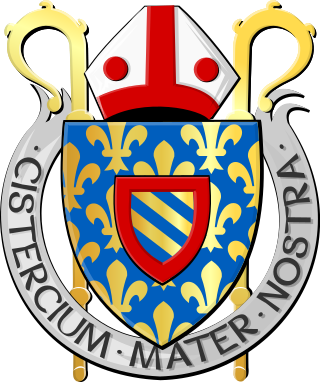
The Cistercians, officially the Order of Cistercians, are a Catholic religious order of monks and nuns that branched off from the Benedictines and follow the Rule of Saint Benedict, as well as the contributions of the highly-influential Bernard of Clairvaux, known as the Latin Rule. They are also known as Bernardines, after Saint Bernard himself, or as White Monks, in reference to the colour of the "cuculla" or cowl worn by the Cistercians over their habits, as opposed to the black cowl worn by Benedictines.

Fountains Abbey is one of the largest and best preserved ruined Cistercian monasteries in England. It is located approximately 3 miles (5 km) south-west of Ripon in North Yorkshire, near to the village of Aldfield. Founded in 1132, the abbey operated for 407 years, becoming one of the wealthiest monasteries in England until its dissolution, by order of Henry VIII, in 1539.

Jervaulx Abbey in East Witton in North Yorkshire, 14 mi (23 km) north-west of the city of Ripon, was one of the great Cistercian abbeys of Yorkshire, England, dedicated to St Mary in 1156. It is a Grade I listed building.
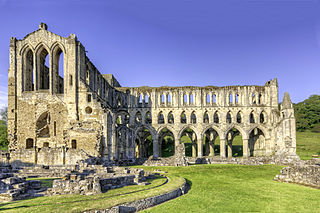
Rievaulx Abbey was a Cistercian abbey in Rievaulx, near Helmsley, in the North York Moors National Park, North Yorkshire, England. It was one of the great abbeys in England until it was seized in 1538 under Henry VIII during the Dissolution of the Monasteries. The wider site was awarded Scheduled Ancient Monument status in 1915 and the abbey was brought into the care of the then Ministry of Works in 1917. The ruins of its main buildings are today a tourist attraction, owned and maintained by English Heritage.

The Abbey Church of the Holy Cross is an ancient foundation in Shrewsbury, the county town of Shropshire, England.
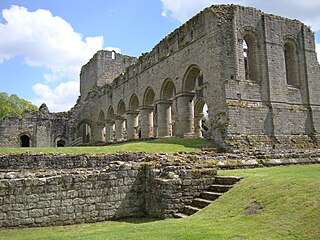
Buildwas Abbey was a Cistercian monastery located on the banks of the River Severn, at Buildwas in Shropshire, England - today about 2 miles (3.2 km) west of Ironbridge. Founded by the local bishop in 1135, it was sparsely endowed at the outset but enjoyed several periods of growth and increasing wealth: notably under Abbot Ranulf in the second half of the 12th century and again from the mid-13th century, when large numbers of acquisitions were made from the local landed gentry. Abbots were regularly used as agents by the Plantagenet monarchs in their attempts to subdue Ireland and Wales and the abbey acquired a daughter house in each country.
Vale Royal Abbey is a former medieval abbey and later country house in Whitegate, England. The precise location and boundaries of the abbey are difficult to determine in today's landscape. The original building was founded c. 1270 by the Lord Edward, later Edward I, for Cistercian monks. Edward had supposedly taken a vow during a rough sea crossing in the 1260s. Civil wars and political upheaval delayed the build until 1272, the year he inherited the throne. The original site at Darnhall was unsatisfactory, so was moved a few miles north to the Delamere Forest. Edward intended the structure to be on a grand scale—had it been completed it would have been the largest Cistercian monastery in the country—but his ambitions were frustrated by recurring financial difficulties.
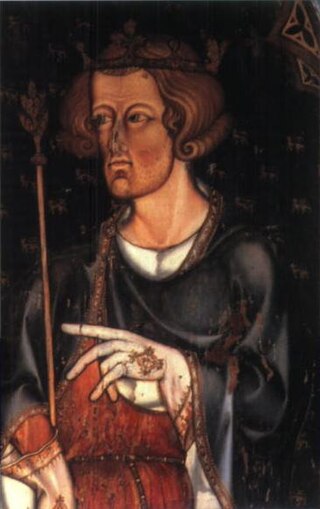
Darnhall Abbey was a late-thirteenth century Cistercian abbey at Darnhall, Cheshire, founded by Lord Edward sometime in the years around 1270. This was in thanks, so tells the Abbey's chronicler, for God saving him and his fleet from a storm at sea. It was dedicated to St Mary. It only existed for a short time before it moved to the better-known Vale Royal Abbey. The site chosen for the Abbey at Darnhall was discovered to be unfit for its purpose. Money was short, as Edward did not provide enough for the original foundation, but the Abbey was allowed to trade wool to augment its finances. The Abbey relocated a few miles north, and what remained of Darnhall Abbey became the monastic grange of the new foundation. There was probably only ever one Abbot of Darnhall before the Abbey relocated in 1275.
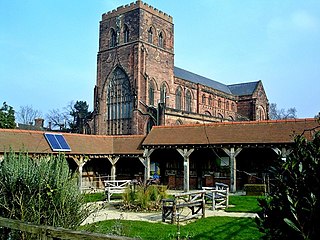
Thomas Prestbury was an English medieval Benedictine abbot and university Chancellor.

The recorded abbots of Shrewsbury run from c 1087, four years after Shrewsbury Abbey's foundation, to 1540, its dissolution under Thomas Cromwell. The abbey was large and well-endowed and the abbots were often important political figures as well as ecclesiastical leaders. They varied greatly over the centuries in ethnic and social origins, intellectual attainments and holiness of life. The first two, Fulchred and Godfred, were imported from Normandy. The remainder seem to have been born in Britain and most, but not all, were elected, or at least selected, from the chapter of the abbey. As important territorial magnates, the abbots were always called to take part in the sessions of Parliament from its very beginnings as an institution in 1265. As important figures in the Western Catholic Church, abbots were permitted by the Pope to wear the pontifical ring from 1251 and the mitre from 1397.
In the early fourteenth century, tensions between villagers from Darnhall and Over, Cheshire, and their feudal lord, the Abbot of Vale Royal Abbey, erupted into violence over whether they had villein—that is, servile—status. The villagers argued not, while the Abbey believed it was due the villagers' feudal service.
Stephen, was a late 14th-century abbot of Vale Royal Abbey in Cheshire. He is believed to have been born c. 1346, and in office from 27 January 1373 to possibly 1400, although the precise date of his departure is unknown. One of the earliest mentions of him as Abbot is 1373, when he received the homage of Robert Grosvenor for the manor of Lostock. He witnessed a charter between the prior of the Augustinian hermits in Warrington and the convent there in 1379. A few years later, Abbot Stephen provided evidence for the Royal Commission that was enquiring into the case of Scrope v Grosvenor, which sat for three years, concluding its business in 1389.
John Chaumpeneys was the last Abbot of Darnhall Abbey and first Abbot of Vale Royal Abbey, Cheshire, from around 1275 to circ 1289.
Walter of Hereford was a twelfth- and thirteenth-century Abbot of Vale Royal Abbey in Cheshire. He was Abbot from around 1294 to approximately 1307. His abbacy occurred at a time of tribulation for the abbey, mostly due to poor relations with the local populace. Walter is in portrayed in his Abbey's later chronicler in superlatives. He is described as "greatly venerable in life and always and everywhere devoted to God and the Blessed Virgin Mary" and as
A man of most beautiful appearance, as regards externals...and in good works also he fought a good fight for Christ, for he used a hair shirt to conquer the flesh, and by this discipline subdued it to the spirit. He rarely or never ate meat.
John of Hoo was an early fourteenth-century Abbot of Vale Royal Abbey, Cheshire. His abbacy was from around 1308–09 to 1314–15.
Richard of Evesham was Abbot of Vale Royal from 1316 to 1342.
Peter was an English Cistercian abbot who served as the fifth abbot of Vale Royal Abbey, Cheshire, in the first half of the 14th century. He is generally held to be the author of the abbey's own chronicle, which was published in 1914 as the Ledger of Vale Royal Abbey. Owing to a failure to finish the abbey's building works—which had commenced in 1277 and had been intermittently ongoing ever since—the abbey was unsightly, and the monks' quarters probably near derelict. Abbot Peter oversaw the transplantation of the house onto new grounds. Much of his career, however, was focussed on defending his abbey's feudal lordship over its tenants. The dispute between the abbey and its tenantry had existed since the abbey's foundation; the abbot desired to enforce his feudal rights, the serfs to reject them, as they claimed to be by then freemen. This did not merely involve Abbot Peter defending the privileges of his house in the courts. Although there was much litigation, with Abbot Peter having to defend himself to the Justice of Chester and even the King on occasion, by 1337 his discontented villagers even followed him from Cheshire to Rutland. A confrontation between Abbot Peter and his tenants resulted in the death of a monastic servant and his own capture and imprisonment. With the King's intervention, however, Abbot Peter and his party were soon freed.
Thomas Ragon was the eighth Abbot of Vale Royal Abbey, Cheshire. His term of office lasted from 1351 to 1369. His abbacy was predominantly occupied with recommencing the building works at Vale Royal—which had been in abeyance for a decade—and the assertion of his abbey's rights over a satellite church in Llanbadarn Fawr, Ceredigion, which was also claimed by the Abbot of Gloucester.
John was Abbot of Vale Royal Abbey, Cheshire, between 1405 and 1411, and although his abbacy seems to have been largely free of the local disorder that had plagued those of his predecessors, the Abbey appears to have been taken in to King Henry IV's hands on at least two occasions.
Vale Royal Abbey is a medieval abbey, and later a country house, located in Whitegate, between Northwich and Winsford in Cheshire, England. During its 278-year period of operation, it had at least 21 abbots.
References
- 1 2 Smith & London 2001, p. 318.
- ↑ Brownbill 1914, pp. 20–23.
- 1 2 Brownbill 1914, pp. 62–83.
- ↑ Bostock & Hogg 1999, p. 3.
- 1 2 Donnelly 1954, p. 443.
- ↑ Brownbill 1914, pp. 79–89.
- 1 2 3 Fishwick 1874, p. 32.
- ↑ Powicke 1947, p. 723.
- 1 2 V. C. H. 1980, pp. 156–65.
Bibliography
- Bostock, A. J.; Hogg, S. M. (1999). Vale Royal Abbey and the Cistercians 1277-1538. Northwich: Northwich & District Heritage Society. OCLC 50667863.
- Brownbill, J., ed. (1914). The Ledger Book of Vale Royal Abbey. Manchester: Manchester Record Society.
- Donnelly, J. (1954). "Changes in the Grange Economy of English and Welsh Cistercian Abbeys, 1300-1540". Traditio. 10: 399–458. doi:10.1017/S0362152900005924. OCLC 557091886.
- Fishwick, H. (1874). The History of the Parish of Kirkham: In the County of Lancaster. Manchester: Chetham Society. p. 32.
- Powicke, F. M. (1947). King Henry III and the Lord Edward. Vol. II. Oxford: Oxford University Press. ISBN 978-0198212447.
- Smith, C. M.; London, V. C. M. (2001). The Heads of Religious Houses: England and Wales, 1216–1377. Vol. II. Cambridge: Cambridge University Press. ISBN 978-1-139-42892-7.
- V. C. H. (1980). Elrington, C. R.; Harris, B. E. (eds.). "Houses of Cistercian monks: The abbey of Vale Royal". Victoria County History. A History of the County of Chester, III. London.